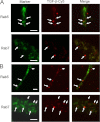Engulfment protein GULP is regulator of transforming growth factor-β response in ovarian cells
- PMID: 22451657
- PMCID: PMC3370247
- DOI: 10.1074/jbc.M111.314997
Engulfment protein GULP is regulator of transforming growth factor-β response in ovarian cells
Abstract
Transforming growth factor β (TGF-β) is a key regulatory molecule with pleiotropic effects on cell growth, migration, and invasion. As a result, impairment of proper TGF-β signaling is central to tumorigenesis and metastasis. The TGF-β receptor V (TGFBRV or LRP1) has been shown to be responsible for TGF-β-mediated cell growth inhibition in Chinese hamster ovary (CHO) cells. The LRP1 adapter protein GULP mediates internalization of the various LRP1-specific ligands, and we hypothesize that GULP acts as a novel regulator of TGF-β signaling in ovarian cells. CHO cells that overexpress exogenous GULP (FL) demonstrate enhancement in growth inhibition, migration, and invasion from TGF-β treatment, whereas cells that lack GULP (AS) show impairment of growth inhibition and decreased migration and invasion. The enhanced TGF-β response in FL cells was confirmed by a prolonged TGF-β-induced SMAD3 phosphorylation, whereas a shortening of the phosphorylation event is observed in AS cells. Mechanistically, the presence of GULP retains the TGF-β in a signaling-competent early endosome for enhanced signaling. To address this mechanism in a physiological setting, TGF-β insensitive ovarian adenocarcinoma cells (HEY) have a very low GULP expression level, similar to the observation made in a wide selection of human ovarian adenocarcinomas. Transfection of GULP into the HEY cells restored the TGF-β responsiveness, as measured by SMAD3 phosphorylation and impairment of cell growth. Because GULP expression positively regulates TGF-β signaling leading to growth inhibition, this may represent an attractive target to achieve TGF-β responsiveness in ovarian cells.
Figures










Similar articles
-
TGF-β/SMAD3 Pathway Stimulates Sphingosine-1 Phosphate Receptor 3 Expression: IMPLICATION OF SPHINGOSINE-1 PHOSPHATE RECEPTOR 3 IN LUNG ADENOCARCINOMA PROGRESSION.J Biol Chem. 2016 Dec 30;291(53):27343-27353. doi: 10.1074/jbc.M116.740084. Epub 2016 Nov 17. J Biol Chem. 2016. PMID: 27856637 Free PMC article.
-
The lipoprotein receptor-related protein-1 (LRP) adapter protein GULP mediates trafficking of the LRP ligand prosaposin, leading to sphingolipid and free cholesterol accumulation in late endosomes and impaired efflux.J Biol Chem. 2006 Apr 28;281(17):12081-92. doi: 10.1074/jbc.M600621200. Epub 2006 Feb 22. J Biol Chem. 2006. PMID: 16497666
-
Tumour necrosis factor-α-induced protein 8-like 2 is a novel regulator of proliferation, migration, and invasion in human rectal adenocarcinoma cells.J Cell Mol Med. 2019 Mar;23(3):1698-1713. doi: 10.1111/jcmm.14065. Epub 2019 Jan 13. J Cell Mol Med. 2019. PMID: 30637920 Free PMC article.
-
PDLIM5 inhibits STUB1-mediated degradation of SMAD3 and promotes the migration and invasion of lung cancer cells.J Biol Chem. 2020 Oct 2;295(40):13798-13811. doi: 10.1074/jbc.RA120.014976. Epub 2020 Jul 31. J Biol Chem. 2020. PMID: 32737199 Free PMC article.
-
Smad3 phosphoisoform-mediated signaling during sporadic human colorectal carcinogenesis.Histol Histopathol. 2006 Jun;21(6):645-62. doi: 10.14670/HH-21.645. Histol Histopathol. 2006. PMID: 16528675 Review.
Cited by
-
Unveiling Genetic Potential for Equine Meat Production: A Bioinformatics Approach.Animals (Basel). 2024 Aug 22;14(16):2441. doi: 10.3390/ani14162441. Animals (Basel). 2024. PMID: 39199974 Free PMC article.
-
Long Noncoding RNA NHEG1 Drives β-Catenin Transactivation and Neuroblastoma Progression through Interacting with DDX5.Mol Ther. 2020 Mar 4;28(3):946-962. doi: 10.1016/j.ymthe.2019.12.013. Epub 2020 Jan 11. Mol Ther. 2020. PMID: 31982037 Free PMC article.
-
Identification of an Immunogenic Medulloblastoma-Specific Fusion Involving EPC2 and GULP1.Cancers (Basel). 2021 Nov 21;13(22):5838. doi: 10.3390/cancers13225838. Cancers (Basel). 2021. PMID: 34830991 Free PMC article.
-
A parasite DNA binding protein with potential to influence disease susceptibility acts as an analogue of mammalian HMGA transcription factors.PLoS One. 2023 Jun 5;18(6):e0286526. doi: 10.1371/journal.pone.0286526. eCollection 2023. PLoS One. 2023. PMID: 37276213 Free PMC article.
-
Insulin-like growth factor binding protein-3 (IGFBP-3): Novel ligands mediate unexpected functions.J Cell Commun Signal. 2013 Aug;7(3):179-89. doi: 10.1007/s12079-013-0203-9. J Cell Commun Signal. 2013. PMID: 23700234 Free PMC article.
References
-
- Roberts A. B., Sporn M. B. (1985) Transforming growth factors. Cancer Surv. 4, 683–705 - PubMed
-
- Sporn M. B., Roberts A. B., Wakefield L. M., Assoian R. K. (1986) Transforming growth factor-β. Biological function and chemical structure. Science 233, 532–534 - PubMed
-
- Zhou L., Leung B. S. (1992) Growth regulation of ovarian cancer cells by epidermal growth factor and transforming growth factors α and β1. Biochim. Biophys. Acta 1180, 130–136 - PubMed
-
- Massagué J. (1998) TGF-β signal transduction. Annu. Rev. Biochem. 67, 753–791 - PubMed
-
- Blobe G. C., Schiemann W. P., Lodish H. F. (2000) Role of transforming growth factor β in human disease. N. Engl. J. Med. 342, 1350–1358 - PubMed
MeSH terms
Substances
LinkOut - more resources
Full Text Sources
Medical
Research Materials
Miscellaneous

